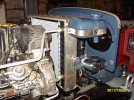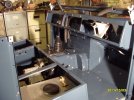dag019
Well-Known Member
Before getting too carried away this thread is an entirely hypothetical idea that I am exploring feasibility of, both in terms of practicality to build and also the legal implications of making drivable and road legal. I am also considering vague cost but am aware projects like this tend to increase in cost as they go through. I have finished rebuilt my 110 following an engine fire and am looking for another project to keep me busy. However This is likly to be a slow burner (if at all) as although I want another project I am expecting my first child at Christmas and I know that will change everything dramatically!
I would like something similar to the below, but they do not seem very common in the UK and with the prices of series vehicles now, even if I could find one, it would either be a complete restoration project or be prohibitively expensive. It would also would still come with all of the drawbacks of using a series vehicle in modern road conditions (I have a series III so please don't try to convince me there are no draw backs!)


I have just finished rebuilding my 200tdi 110 which is now back in service as my daily vehicle doing about 30k miles a year. So, whereas I know this also comes with drawbacks, it is far more usable than the series is. There are also far more s/h parts available at sensible prices for defenders than there is for the series.
How feasible would it be to take a tdi powered 110 chassis, all suspension, axles, running gear etc., engine and gearboxes and then fit an older style cab body onto it? Ignore the flatbed back for now as by comparison that is easy and is "just" making brackets to attach a bed to the rear chassis. I know legally it would still be the 110 registration etc. I not trying to claim it as a series vehicle for tax/mot exception etc.
There seems to be enough 110 rolling chassis/ abandoned projects for sensible money that the rolling running chassis should be fairly easy to get up and together and I am happy with rebuilding all of the mechanicals required to do this and patching a chassis if required.
I know with some ingenuity you can fit a 200tdi under the bonnet of a series motor as people have done engine conversion, similar with the pas system. I also believe that a series II/III body is the same width as a defender so the bulkhead outriggers should require no modification and a series bulkhead would just bolt straight on, is this correct? Getting series body panels is easy enough and you can get new galv bulkheads etc no problem. The cab roof and rear bulkhead is also readily available even if it needs a wrecked tub to be cut down to get the rear bulkhead.
Having said that I would prefer a series 1 body which I know is narrower. Getting series 1 front end body panels and doors second hand is relatively easy even if there is not as many as there are later series models. I also believe that similarly to the later series models you can get new replacement bulkheads. However I am not sure how easy it would be to get the cab roof and the rear bulkead and would not want to cut down a series 1 tub in the same way I would a later model one. I also assume this would need the bulkhead outrigger modifying and shortening to take the narrower bulkhead, would this case issue with the legality as a chassis modification?
I would be looking at either creating my own wiring loom or modifying a defender wiring loom for the electrics but it would be a very basic set of vehicle electrics with everything required for the engine to run, lights and wipers, and maybe a heater. I am certainly not looking for all the modern electrical tat like power windows and central locking. I happily built an auxiliary loom for my 110 for everything extra to be stand alone using blue sea fuse boxes and relay boxes so am competent enough with most defender level vehicle electrics even if it is not something I would say I enjoy.
I know hybrids seem to have dropped out of fashion these days after being very popular when you could get rusty range rovers for penny's but have I missed something very basic to make this a non starter or theoretically can you get a running driving 110 chassis and drop a series cab body onto it with very little fuss and modification?
I would like something similar to the below, but they do not seem very common in the UK and with the prices of series vehicles now, even if I could find one, it would either be a complete restoration project or be prohibitively expensive. It would also would still come with all of the drawbacks of using a series vehicle in modern road conditions (I have a series III so please don't try to convince me there are no draw backs!)
I have just finished rebuilding my 200tdi 110 which is now back in service as my daily vehicle doing about 30k miles a year. So, whereas I know this also comes with drawbacks, it is far more usable than the series is. There are also far more s/h parts available at sensible prices for defenders than there is for the series.
How feasible would it be to take a tdi powered 110 chassis, all suspension, axles, running gear etc., engine and gearboxes and then fit an older style cab body onto it? Ignore the flatbed back for now as by comparison that is easy and is "just" making brackets to attach a bed to the rear chassis. I know legally it would still be the 110 registration etc. I not trying to claim it as a series vehicle for tax/mot exception etc.
There seems to be enough 110 rolling chassis/ abandoned projects for sensible money that the rolling running chassis should be fairly easy to get up and together and I am happy with rebuilding all of the mechanicals required to do this and patching a chassis if required.
I know with some ingenuity you can fit a 200tdi under the bonnet of a series motor as people have done engine conversion, similar with the pas system. I also believe that a series II/III body is the same width as a defender so the bulkhead outriggers should require no modification and a series bulkhead would just bolt straight on, is this correct? Getting series body panels is easy enough and you can get new galv bulkheads etc no problem. The cab roof and rear bulkhead is also readily available even if it needs a wrecked tub to be cut down to get the rear bulkhead.
Having said that I would prefer a series 1 body which I know is narrower. Getting series 1 front end body panels and doors second hand is relatively easy even if there is not as many as there are later series models. I also believe that similarly to the later series models you can get new replacement bulkheads. However I am not sure how easy it would be to get the cab roof and the rear bulkead and would not want to cut down a series 1 tub in the same way I would a later model one. I also assume this would need the bulkhead outrigger modifying and shortening to take the narrower bulkhead, would this case issue with the legality as a chassis modification?
I would be looking at either creating my own wiring loom or modifying a defender wiring loom for the electrics but it would be a very basic set of vehicle electrics with everything required for the engine to run, lights and wipers, and maybe a heater. I am certainly not looking for all the modern electrical tat like power windows and central locking. I happily built an auxiliary loom for my 110 for everything extra to be stand alone using blue sea fuse boxes and relay boxes so am competent enough with most defender level vehicle electrics even if it is not something I would say I enjoy.
I know hybrids seem to have dropped out of fashion these days after being very popular when you could get rusty range rovers for penny's but have I missed something very basic to make this a non starter or theoretically can you get a running driving 110 chassis and drop a series cab body onto it with very little fuss and modification?



